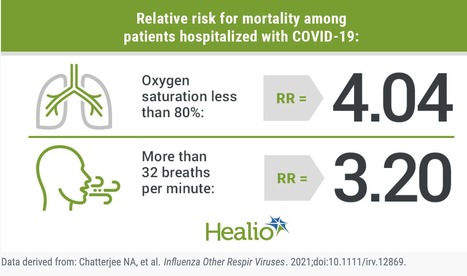Patients with COVID-19 who had decreased oxygen saturation or increased respiratory rate at hospital admission had a “markedly elevated” risk for mortality, according to researchers. Based on the findings, the researchers recommend that patients with COVID-19, particularly those at greater risk for adverse outcomes, monitor their blood-oxygen levels and respiratory rates at home “in order to expedite life-saving treatments.” “COVID-19 patients often have unrecognized hypoxemia without experiencing overt respiratory symptoms, resulting in a missed opportunity to institute early, potentially life-saving treatment.” Neal A. Chatterjee, MD, MSc, a cardiologist, cardiac electrophysiologist and an assistant professor of medicine at University of Washington School of Medicine, and colleagues wrote. Although the CDC and WHO advise patients with COVID-19 to seek care if they have “trouble breathing,” currently, there is no guidance to assess for “objective signs of respiratory insufficiency at home, such as oxygen saturation or respiratory rate,” according to the researchers.
Chatterjee and colleagues conducted a retrospective cohort study to determine whether there is an association between initial oxygen saturation and respiratory rate and all-cause mortality in patients hospitalized with COVID-19. The analysis included 1,095 adults (mean age, 58 years; 62% men) who were hospitalized for COVID-19 at the University of Washington in Seattle or Rush University in Chicago between March 1, 2020, and June 8, 2020. Physicians reviewed patients’ charts to obtain patient information and clinical outcomes. Patients had a mean oxygen saturation of 91% and a mean respiratory rate of 23 breaths per minute, but only 10% of patients reported shortness of breath and 25% reported cough, according to the researchers. Additionally, 73% of patients presented with fever. Among the study population, 197 died in the hospital. Initial oxygen saturation was associated with a risk for mortality. The relative risk for mortality was 4.04 (95% CI, 2.96-5.51) in patients with an oxygen saturation less than 80%; 2.34 (95% CI, 1.46-3.76) in patients with an oxygen saturation of 80% to 84%; 1.92 (95% CI, 1.31-2.81) in patients with an oxygen saturation of 85% to 88%; and 1.79 (95% CI, 1.18-2.7) in patients with an oxygen saturation of 89% to 91%.
Respiratory rate at admission was also associated with a relative risk for mortality, according to Chatterjee and colleagues. The relative risk for mortality was 3.2 (95% CI, 2.25-4.54) in patients with more than 32 breaths per minute; 2.06 (95% CI, 1.34-3.16) in patients with 29 to 32 breaths per minute; 1.72 (95% CI, 1.15-2.57) in patients with 25 to 28 breaths per minute; 1.89 (95% CI, 1.28-2.79) in patients with 23 to 24 breaths per minute; and 1.37 (95% CI, 0.9-2.1) in patients with 21 to 22 breaths per minute. “In summary, indices of respiratory compromise at initial presentation, that are readily measurable at home, are associated with markedly elevated risk of in-hospital mortality in COVID-19 patients,” the researchers wrote. “Public health strategies emphasizing the importance of at-home surveillance of oxygen saturation and respiratory rate may identify at-risk patients earlier and enable timely institution of life-saving medical therapy.”
Research Published in Influenza and Other Respiratory Viruses (May 24, 2021):



 Your new post is loading...
Your new post is loading...







